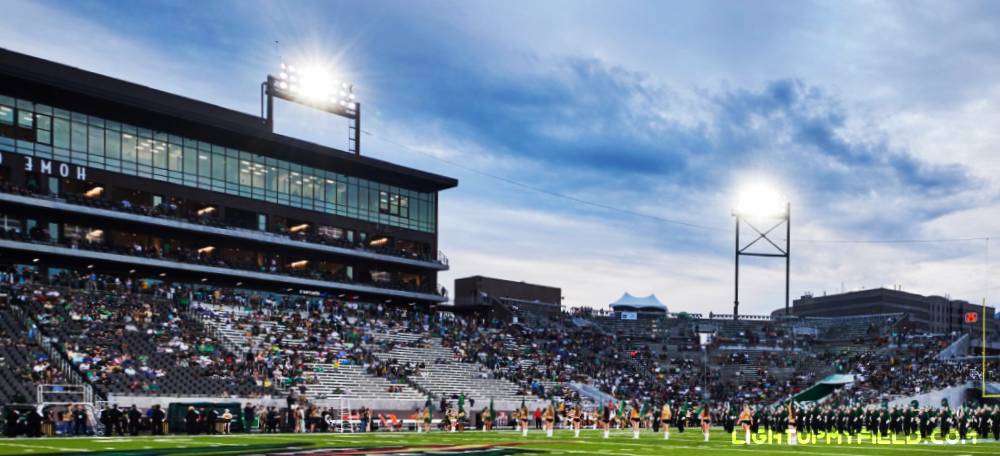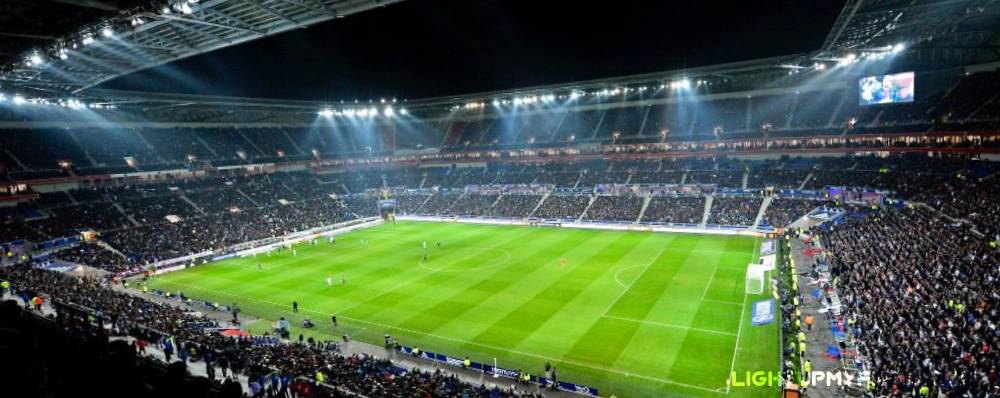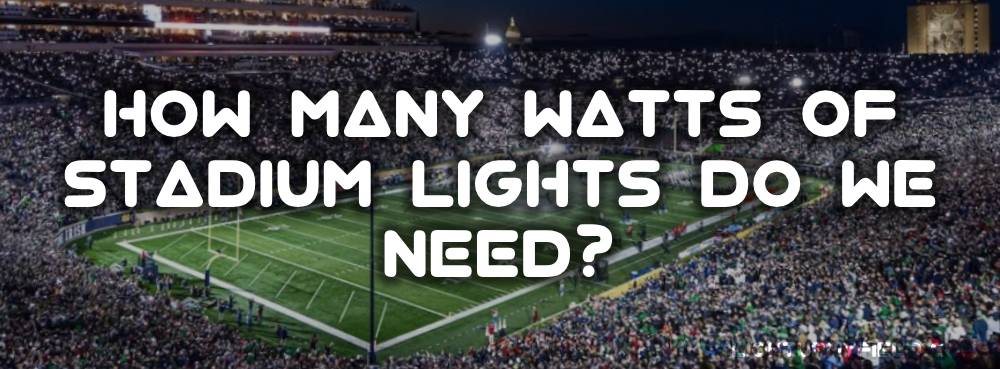Ever wondered how much power goes into lighting a stadium so it looks bright and clear, whether it’s for a local community match or an international broadcast? The question of how many watts stadium lights require isn’t straightforward—it depends on a mix of ground-level brightness targets, field size, fixture type, and the competitive level.
We will explore why choosing the right wattage matters, outlines typical wattage ranges used in stadium lighting, digs into the factors that influence those choices, supplies some numbers, and even links to authoritative standards from respected institutions.
Table of Contents
ToggleImportance of Selecting the Right Wattage
Getting the wattage right isn’t just about saving energy—it affects visibility for players and referees, spectator comfort, and broadcast picture quality too. Power levels that are too low can cause shadowy spots and poor visibility. On the other hand, overly high wattage can lead to glare, energy waste, and light spilling into surrounding areas.
Standards like BS EN 12193:2007 define minimum illuminance levels (measured in lux) for various types of sports and competition classes, and wattage choices have to make those lux targets achievable across the field evenly. Meanwhile, bodies like FIFA stress that lighting systems need to support broadcasting needs reliably, and redundancy in power must be considered early in design. So picking the right wattage is about more than just brightness—it’s about planning for real-world performance, safety, and broadcast reliability.
The Common Wattage of Stadium Lighting

You might think there’s a magic number that works for every stadium, but the truth is wattage requirements vary a lot depending on the size of the field, the sport being played, and the level of play. That said, we can outline some practical ranges to give you a sense of what’s typical.
| Level of Play | Target Lux | Typical Fixture Wattage | Estimated Fixture Count | Total Power (Traditional) | Total Power (LED) |
|---|---|---|---|---|---|
| Recreational / Training | 200–300 lux | 400W – 800W | 12–20 | ~7,000–12,000W | ~3,000–5,000W |
| Amateur / Semi-Pro | 500–750 lux | 800W – 1,500W | 30–40 | ~30,000–40,000W | ~12,000–18,000W |
| Professional / Televised | 1,500–2,000 lux | 1,500W – 2,000W+ | 150–200 | 225,000–300,000W | ~70,000–100,000W |
For recreational or training fields, the goal is usually around 200–300 lux, which is enough for casual games and practice sessions. To achieve this, stadiums typically use fixtures in the 400W to 800W range each. For example, a small soccer pitch or local baseball diamond might need 12–20 fixtures at 600W each, adding up to around 7,000–12,000 watts in total.
Move up to amateur or semi-pro venues, and the standards get higher—usually 500–750 lux. These scenarios often call for fixtures rated between 800W and 1500W. A mid-sized football field might need 30–40 fixtures at 1000W each, giving a total system power of 30,000 to 40,000 watts.
Now, when you step into professional or televised arenas, the bar rises dramatically. Broadcast-quality lighting usually requires 1,000 lux or more, and many stadiums shoot for 1,500 to 2,000 lux to satisfy HD or UHD broadcast requirements. At these levels, each fixture might be rated 1,500W to 2,000W or even more, depending on the beam angle and pole height. For example, a major soccer stadium could use 150–200 fixtures averaging 1,500W, which translates to a whopping 225,000 to 300,000 watts of installed power if you’re using older technologies like metal halide. Fortunately, modern LEDs make this far more efficient.
LED fixtures are a game-changer here. With an efficacy of around 120–160 lumens per watt, you can hit the same lux level with significantly less wattage. For instance, instead of needing 300,000 watts with metal halide lamps, you might achieve the same result with 70,000–100,000 watts using LEDs. That’s roughly a 60–70% reduction in energy consumption, which makes a huge difference over time in both operating costs and environmental impact.
Let’s put this into a real-world example. A standard FIFA-regulation soccer pitch measures about 105 meters by 68 meters, giving an area of roughly 7,140 square meters. To light that field to 1,500 lux, you need:
Illuminance target: 1,500 lux
Area: 7,140 m²
Total lumens required = 1,500 × 7,140 = 10,710,000 lumens
If your LED fixtures deliver 140 lumens per watt, you divide 10,710,000 by 140 and get around 76,500 watts total. Add a 15% buffer for uniformity and aiming losses, and you’re looking at roughly 88,000 watts. That could be achieved with 55 fixtures at 1,600W each or 70 fixtures at 1,250W each, depending on the design layout and beam control.
Compare that to older metal halide systems: with an average efficacy of 90 lumens per watt, you’d need 119,000 watts or more to hit the same target—and that doesn’t even factor in warm-up times, shorter lamp life, or higher maintenance costs.
So when you see those massive light towers around professional arenas, it’s not just for show. They’re pumping out millions of lumens to make sure players, referees, and fans (both in the stands and at home) can see every detail clearly.
Factors Affecting the Wattage
When people ask, “How many watts do stadium lights need?” the truth is, there isn’t a single answer that works for every situation. Wattage depends on several variables, from the size of the playing field to the lighting standards you’re aiming for. Let’s break down the main factors that really drive those numbers.
Level of Competition and Lux Requirements
One of the biggest drivers of wattage is the level of play. The lighting needs for a local recreational field are miles apart from those of a major broadcast stadium. International standards, such as BS EN 12193:2007, define three general classes for sports lighting:
- Class I: International or top-tier professional play
- Class II: National or club-level play
- Class III: Community or recreational fields
For football (soccer), Class I typically requires around 500 lux on the horizontal plane. Class II usually falls around 200 lux, and Class III can be as low as 75 lux. But here’s the kicker—if the game is being televised in high-definition (or even 4K), you’re looking at way higher numbers. Many broadcast standards push for 1,500 to 2,000 lux, which is well beyond the minimum Class I requirement.
Higher lux targets don’t just mean brighter lights; they mean more fixtures, higher wattage per fixture, and an overall increase in the total installed load. For instance, jumping from 500 lux to 1500 lux doesn’t triple the wattage exactly, but it can easily double or more the total power requirement, especially when you factor in uniformity and glare control.

Field Size and Fixture Layout
Next up is the size of the playing surface. A full FIFA-standard soccer pitch measures about 105 meters by 68 meters, which works out to roughly 7,140 square meters. Lighting that entire area evenly takes a serious amount of lumens. Compare that to a small training ground or local baseball diamond, and you can see why big stadiums demand so much more power.
It’s not just about field dimensions, though. The height and placement of light poles matter too. Taller poles—say 30 meters or more—let you cover a larger area with fewer poles, but here’s the trade-off: the higher the fixture, the more wattage it needs to punch light down to field level effectively. So a stadium with very tall masts might rely on 2,000W fixtures, whereas a community field with shorter poles can often get away with 800W to 1,200W lights.
Even spacing affects this. Widely spaced poles mean the beams have to travel further and spread more, which again bumps up the required wattage.
Fixture Efficiency and Technology
Technology has completely changed the game when it comes to wattage. Older metal halide or high-pressure sodium (HPS) fixtures typically produced around 70–90 lumens per watt. That meant hitting a target of 1,000 lux on a big field could require over 150,000 watts of power.
LED technology flips that equation. Today’s stadium-grade LEDs usually deliver 120–160 lumens per watt, which means you can hit the same lighting levels using 40–60% less power than before. So if an old metal halide setup needed 200,000 watts, an LED system might pull that off with 80,000 to 100,000 watts. That’s a huge difference in both energy bills and carbon footprint.
On top of that, LEDs turn on instantly (no 15-minute warm-up like metal halide), last longer, and allow for precise control of light direction and intensity. All of this makes them the clear favorite for modern stadium lighting projects.
Uniformity and Glare Control
You can’t just blast light from a few super-powerful fixtures and call it a day. Sports lighting standards (like those in EN 12193) require a certain level of uniformity—basically, the light should look smooth and even across the field. Typically, the minimum-to-average illuminance ratio should be 0.7 or better, depending on the sport and level of competition.
To achieve that, designers often need multiple fixtures overlapping their beams. Sometimes, instead of using fewer high-wattage lights, it’s better to use more moderate-wattage fixtures spread around the stadium. This not only helps with uniformity but also reduces glare for players and spectators.
Glare is a real issue. Poorly aimed, overly bright fixtures can cause visual discomfort and even affect player performance. So achieving the perfect balance often means more lights rather than just bigger ones.
Backup Power and Reliability
One factor many people overlook is backup power. Governing bodies like FIFA expect stadiums to maintain adequate lighting even if the main power supply fails. This means having redundant power systems—such as generators or UPS (uninterruptible power supply) setups—that can instantly take over during an outage.
From a wattage perspective, this doesn’t necessarily increase the amount of light on the field, but it does double up the infrastructure you need to support that load. For example, if your lighting system needs 80,000 watts, your backup system also needs to be sized for the same load to keep the game going without interruption.

